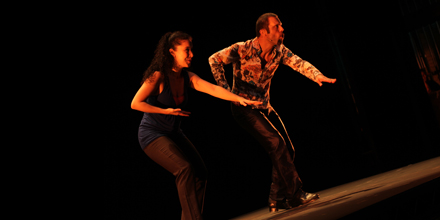
On Friday, April 8th, Pentacle Roster artist, Max Pollak will perform as part of The Sheen Center’s new musical series: 2: The Art of the Duo. The evening features solo and duet performances from Pollak, and Brazilian percussionist, Cyro Baptista. Max Pollak founded his group, RumbaTap to merge authentic Afro-Cuban music and dance with American tap, body percussion, and vocals. Pollak is an accomplished musician as well as a dancer, and this fall, he released RumbaTap– the first music album to feature dance-percussion as the lead voice. More information about next week’s show can be found here.
We spoke with Mr. Pollak about his passion for rumba, making connections with audiences, and his long term artistic collaboration with Mr. Baptista.
Your group is called RumbaTap- when and how did you first discover rumba (Afro-Cuban folklore that has defined Cuban culture for several centuries), and what compelled you to make it a primary focus of your work?
MP: I was first introduced to the form while studying at The New School in a course taught by Bobby Sanabria. I saw footage of [the legendary] Los Muñequitos de Matanzas dancing rumba, and it had a very, very intense impact on me. The liquid motion of the dancers. The interplay between the dancer and the solo drummer. I had never seen anything like it before. I had been working within a jazz context musically, but felt that there was something missing in the expression for me. And as cultural expressions, rumba and jazz are parallel, are siblings. They are not exactly the same, but are derived from similar parentage- European and African roots.
I discovered that in rumba, there is more understanding between the musicians and the dancers then there is in jazz. And I studied the percussion of Rumba– the conga drums, the claves, and from there, I transferred the patterns to my feet and to my hands. And that was the beginning of RumbaTap. With rumba, I am able to express my musical ideas with my feet, my hands and my voice simultaneously.
Your work translates well as both solo and group performances- in locations from tiny club spaces to large concert halls- how do these different kinds of performances inform each other and your practice as a whole?
MP: I have a strong affinity for very intimate performance spaces. Being a New York musician, I’m used to having to play in close quarters on very, very small stages out of necessity. And at the same time, I have also worked as a musical theatre actor, performing on very large Broadway-scale stages, so I know what it feels like on both sides. And also, I have been lucky enough to have experience from the World Music perspective, which has taught me to appreciate an intimate connection with an audience, no matter whether the space is large or small. No matter what the size of the venue, if you make the effort, you can connect, plug into the universal groove.
Is there a particular performance you can recall that exemplifies this kind of connection and expansiveness?
I saw a solo performance at Symphony Space by [famous Brazilian percussionist] Naná Vasconcelos, in which he created weather inside the concert hall. It was an incredible feeling. He made it rain, and storm, and manifested jungle birds- just him with a berimbau and a few shakers and a sequencer, and then the audience. He made the audience into an orchestra. Unbelievable stuff. And that performance had a huge impact on me, and how I make performances. I like to make the audience part of the festivities. They’re part of the orchestra.
At the Sheen Center, you will be sharing the night with Cyro Baptista- you performed as part of his percussion ensemble from 1999 until 2007, and still do shows with him today. How has he influenced your work?
MP: When the Sheen Center asked me to do a duo concert- Cyro was one of the first people who came to mind. He is definitely a mentor of mine- musically and also philosophically. Cyro is a genius, instinctual musician who just knows how to make situations work. He has a sensitivity and sensibility and humor that just makes everything work. He’s very unique in that regard. He knows how to make an audience feel comfortable as soon as he walks on stage. I was able to take a lot of cues from him and learn a lot about how to make an audience feel relaxed and comfortable and entertained while being silly, but not being tasteless. And always at the very very highest level of musical sophistication.
Read more about Max Pollak and RumbaTap here.
Photo © Amy C. Miller
**Max Pollak’s answers have been edited.
